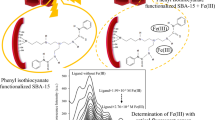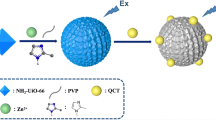Abstract
Covalent organic frameworks (COFs) with good chemical stability, flexible chemical functionalization, tunable pore sizes, and high specific surface areas have been increasingly employed in the field of fluorescence sensing. In this work, a crystalline vinyl-functionalized COF TzDa-V was facilely prepared through a room-temperature synthetic method via condensation reaction between 4,4′,4″-(1,3,5-triazine-2,4,6-triyl)trianiline (Tz) and 2,5-diallyloxyterephthalaldehyde (Da-V). The intermolecular charge transfer (ICT) effect endowed the TzDa-V with fluorescence characteristic, and it was sensitive to trace water and can be quenched due to the disruption of ICT process by water. On this base, the prepared COF TzDa-V with excellent chemical/thermal stability was applied to sensing of trace water in common organic solvents such as DMF, acetone, THF, and ethyl acetate with rapid response (less than 10 s), satisfactory sensing range (0.5–18% water in DMF, 0.5–15% water in acetone, 0.5–16% water in THF, 0.5–5% in ethyl acetate, v/v), and high sensitivity. The limits of detection for water in DMF, acetone, THF, and ethyl acetate were 0.0497%, 0.0590%, 0.0502%, and 0.0766% (v/v), respectively. The proposed probe was successfully used for the detection of trace water in food products such as salt and sugar. The COF TzDa-V would be a good candidate for application in water sensing.
Graphical abstract






Similar content being viewed by others
References
Arabi M, Ostovan A, Li J, Wang X, Zhang Z, Choo J, Chen L (2021) Molecular Imprinting: green perspectives and strategies. Adv Mater 33:2100543
Arabi M, Ostovan A, Zhang Z, Wang Y, Mei R, Fu L, Wang X, Ma J, Chen L (2021) Label-free SERS detection of Raman-Inactive protein biomarkers by Raman reporter indicator: toward ultrasensitivity and universality. Biosens Bioelectron 174:112825
Zhang S, Zhuang X, Chen D, Luan F, He T, Tian Y, Chen L (2019) Simultaneous voltammetric determination of guanine and adenine using MnO2 nanosheets and ionic liquid-functionalized graphene combined with a permeation-selective polydopamine membrane. Microchim Acta 186:450
Ding S, Wang W (2013) Covalent organic frameworks (COFs): from design to applications. Chem Soc Rev 42:548–568
Fenton JL, Burke DW, Qian D, Olvera de la Cruz M, Dichtel WR (2021) Polycrystalline covalent organic framework films act as adsorbents, not membranes. J Am Chem Soc 143:1466–1473
Qian H, Dai C, Yang C, Yan X (2017) High-crystallinity covalent organic framework with dual fluorescence emissions and its ratiometric sensing application. ACS Appl Mater Interfaces 9:24999–25005
Yang Q, Luo M, Liu K, Cao H, Yan H (2020) Covalent organic frameworks for photocatalytic applications. Appl Catal B 276:119174
Fang Q, Wang J, Gu S, Kaspar RB, Zhuang Z, Zheng J, Guo H, Qiu S, Yan Y (2015) 3D porous crystalline polyimide covalent organic frameworks for drug delivery. J Am Chem Soc 137:8352–8355
Wang D, Li N, Hu Y, Wan S, Song M, Yu G, Jin Y, Wei W, Han K, Kuang G, Zhang W (2018) Highly fluoro-substituted covalent organic framework and its application in lithium-sulfur batteries. ACS Appl Mater Interfaces 10:42233–42240
Fu Y, Li Z, Li Q, Hu C, Liu Y, Sun W, Chen Z (2021) In situ room-temperature preparation of a covalent organic framework as stationary phase for high-efficiency capillary electrochromatographic separation. J Chromatogr A 1649:462239
Fang Q, Gu S, Zheng J, Zhuang Z, Qiu S, Yan Y (2014) 3D microporous base-functionalized covalent organic frameworks for size-selective catalysis. Angew Chem Int Ed 53:2878–2882
Kong D, Bao T, Chen Z (2017) In situ synthesis of the imine-based covalent organic framework LZU1 on the inner walls of capillaries for electrochromatographic separation of nonsteroidal drugs and amino acids. Microchim Acta 184:1169–1176
Albacete P, Lopez-Moreno A, Mene-Hernando S, Platero-Prats AE, Perez EM, Zamora F (2019) Chemical sensing of water contaminants by a colloid of a fluorescent imine linked covalent organic framework. Chem Commun 55:1382–1385
Gomes R, Bhaumik A (2016) A new triazine functionalized luminescent covalent organic framework for nitroaromatic sensing and CO2 storage. RSC Adv 6:28047–28054
Das P, Mandal SK (2018) A dual-functionalized, luminescent and highly crystalline covalent organic framework: molecular decoding strategies for VOCs and ultrafast TNP sensing. J Mater Chem A 6:16246–16256
Yu Y, Li G, Liu J, Yuan D (2020) A recyclable fluorescent covalent organic framework for exclusive detection and removal of mercury(II). Chem Eng J 401:126139
Skorjanc T, Shetty D, Valant M (2021) Covalent organic polymers and frameworks for fluorescence-based sensors. ACS Sens 6:1461–1481
Kumar P, Kaushik R, Ghosh A, Jose DA (2016) Detection of moisture by fluorescent off-on sensor in organic solvents and raw food products. Anal Chem 88:11314–11318
Zhou Y, Zhang D, Xing W, Cuan J, Hu Y, Cao Y, Gan N (2019) Ratiometric and turn-on luminescence detection of water in organic solvents using a responsive europium-organic framework. Anal Chem 91:4845–4851
Zhao K, Liu T, Wang G, Chang X, Xue D, Belfield KD, Fang Y (2013) A butterfly-shaped pyrene derivative of cholesterol and its uses as a fluorescent probe. J Phys Chem B 117:5659–5667
Jung HS, Verwilst P, Kim WY, Kim JS (2016) Fluorescent and colorimetric sensors for the detection of humidity or water content. Chem Soc Rev 45:1242–1256
Dong Y, Cai J, Fang Q, You X, Chi Y (2016) Dual-emission of lanthanide metal-organic frameworks encapsulating carbon-based dots for ratiometric detection of water in organic solvents. Anal Chem 88:1748–1752
Deng L, Kang X, Quan T, Yang L, Liu S, Zhang K, Gao M, Xia Z, Gao D (2021) Highly crystalline covalent organic frameworks act as a dual-functional fluorescent-sensing platform for myricetin and water, and adsorbents for myricetin. ACS Appl Mater Interfaces 13:33449–33463
Huang Y, Liu W, Feng H, Ye Y, Tang C, Ao H, Zhao M, Chen G, Chen J, Qian Z (2016) Luminescent nanoswitch based on organic-phase copper nanoclusters for sensitive detection of trace amount of water in organic solvents. Anal Chem 88:7429–7434
Geng K, He T, Liu R, Dalapati S, Tan K, Li Z, Tao S, Gong Y, Jiang Q, Jiang D (2020) Covalent organic frameworks: design, synthesis, and functions. Chem Rev 120:8814–8933
Maschita J, Banerjee T, Savasci G, Haase F, Ochsenfeld C, Lotsch BV (2020) Ionothermal synthesis of imide-linked covalent organic frameworks. Angew Chem Int Ed 59:15750–15758
Ma W, Zheng Q, He Y, Li G, Guo W, Lin Z, Zhang L (2019) Size-controllable synthesis of uniform spherical covalent organic frameworks at room temperature for highly efficient and selective enrichment of hydrophobic peptides. J Am Chem Soc 141:18271–18277
Ji S, Qian H, Yang C, Zhao X, Yan X (2019) Thiol-ene click synthesis of phenylboronic acid-functionalized covalent organic framework for selective catechol removal from aqueous medium. ACS Appl Mater Interfaces 11:46219–46225
Chen Y, Zhang C, Xie J, Li H, Dai W, Deng Q, Wang S (2020) Covalent organic frameworks as a sensing platform for water in organic solvent over a broad concentration range. Anal Chim Acta 1109:114–121
Yi X, Cao Z, Yuan Y, Li W, Cui X, Chen Z, Hu X, Yu A (2021) Design and synthesis of a novel mitochondria-targeted osteosarcoma theranostic agent based on a PIM1 kinase inhibitor. J Control Release 332:434–447
Grabowski ZR, Rotkiewicz K, Rettig W (2003) Structural changes accompanying intramolecular electron transfer: focus on twisted intramolecular charge-transfer states and structures. Chem Rev 2003:3899–4031
Kim TI, Kim Y (2017) A water indicator strip: instantaneous suorogenic detection of water in organic solvents, drugs, and foodstuffs. Anal Chem 89:3768–3772
Ma W, Jiang S, Zhang W (2020) Covalent organic frameworks with electron-rich and electron-defcient structures as water sensing scaffolds. Macromol Rapid Comm 41:2000003
Cheng W, Xie Y, Yang Z, Sun Y, Zhang M, Ding Y, Zhang W (2019) General strategy for in situ generation of a coumarin-Cu2+ complex for fluorescent water sensing. Anal Chem 91:5817–5823
Wu F, Wang L, Tang H, Cao D (2019) Excited state intramolecular proton transfer plus aggregation-induced emission-based diketopyrrolopyrrole luminogen: photophysical properties and simultaneously discriminative detection of trace water in three organic solvents. Anal Chem 2019:5261–5269
Acknowledgements
This work was supported by the National Natural Science Foundation of China (Grant Nos. 82073808 and 81872828).
Author information
Authors and Affiliations
Corresponding author
Ethics declarations
Conflict of interest
The authors declare no competing interests.
Additional information
Publisher's note
Springer Nature remains neutral with regard to jurisdictional claims in published maps and institutional affiliations.
Supplementary Information
Below is the link to the electronic supplementary material.
Rights and permissions
Springer Nature or its licensor holds exclusive rights to this article under a publishing agreement with the author(s) or other rightsholder(s); author self-archiving of the accepted manuscript version of this article is solely governed by the terms of such publishing agreement and applicable law.
About this article
Cite this article
Li, Z., Li, Q., Hu, Z. et al. Determination of water in organic solvents and raw food products by fluorescence quenching of a crystalline vinyl-functionalized COF. Microchim Acta 189, 361 (2022). https://doi.org/10.1007/s00604-022-05432-0
Received:
Accepted:
Published:
DOI: https://doi.org/10.1007/s00604-022-05432-0




